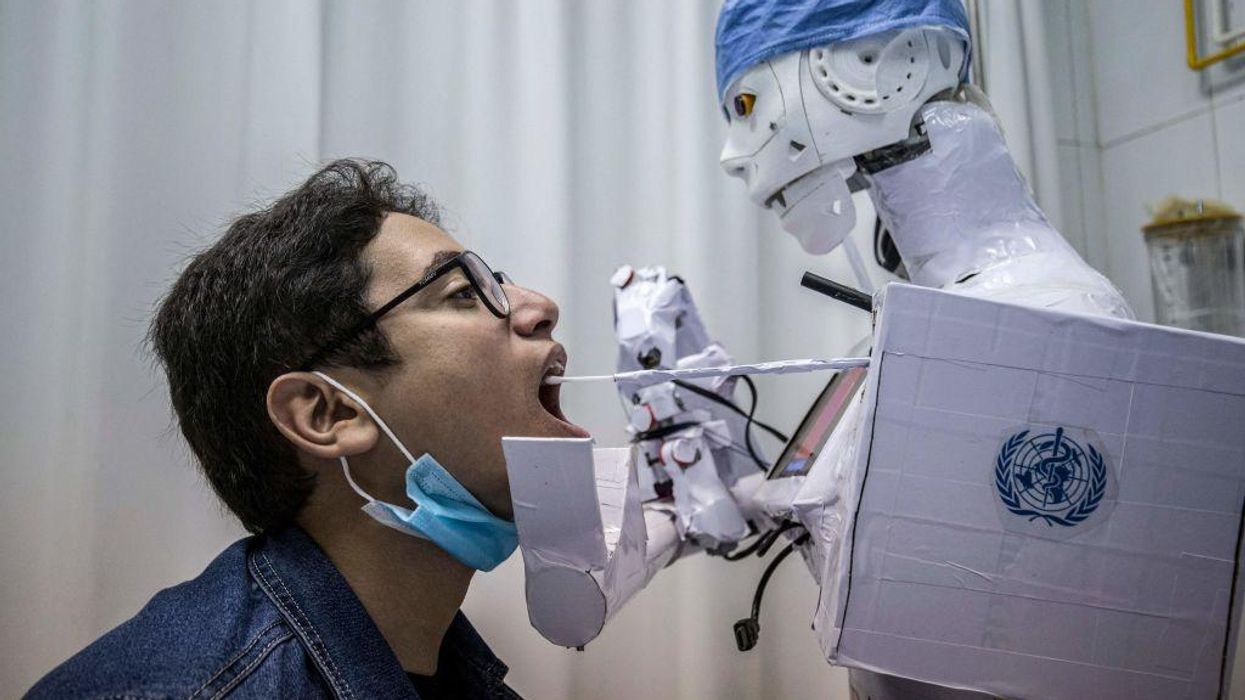
Photo by KHALED DESOUKI/AFP via Getty Images

In Kurt Vonnegut Jr.'s 1952 novel "Player Piano," the nation's managerial class rendered workers — off fighting in the third world war — obsolete by replacing them with machines.
The investment banking firm Goldman Sachs has suggested in a new report that America need not wait for war. In fact, the corporation said America by 2030 will be well on its way to replacing human bodies with metal ones.
Goldman Sachs estimated that in 10 to 15 years, the humanoid robots market will have a market size of approximately $6 billion. Accordingly, it will be capable of filling 4% of the U.S. manufacturing labor needs by 2030 and 2% of global elderly care demand by 2035.
CNBC reported that in Goldman Sachs' "blue-sky scenario," where the "hurdles of product design, use case, technology, affordability and wide public acceptance [are] completely overcome," the humanoid robots market could reach $152 billion by 2035. As a point of comparison, that would be one-third of the global smartphone market circa 2021.
\u201cThe next Car/Phone?\n\nGoldman forecasts that humanoid robots could have the potential to become the next widely adopted device after smartphones & cars:\u201d— Brett Adcock (@Brett Adcock) 1667400014
While labor shortages may previously have been resolved with higher wages or shifts in educational focus, they might soon be remedied with machines such as Tesla's humanoid robot prototype, the "Optimus."
\u201cJUST IN: Tesla, $TSLA officially unveils AI bot 'Optimus'\n\n\u201d— Watcher.Guru (@Watcher.Guru) 1664587480
Like Goldman Sachs, Tesla CEO Elon Musk is similarly bullish concerning the humanoid robot market.
Reuters reported that Musk indicated his robots — he intends to make millions of them — will soon be more valuable than his cars.
Musk's stated goal is an ambitious one: to get the production cost of each humanoid robot under $20,000 and to lead the creation of a "quasi-infinite" economy. He hopes to get the cheaper iteration of the robot to consumers in "three to five years."
According to Musk, some successor of the Optimus might be used in homes to make dinners, mow the lawn, care for geriatric patients, and also service humans' emotional needs.
Clearly, Goldman Sachs does not consider Musk's outlook too audacious.
CNBC reported that in achieving this end, Goldman Sachs recognizes investment opportunities in motion components, gyroscope/inertia measurement units "to keep the robot's balance," sensing modules (e.g., involving camera, radar, ultrasonic, and lidar sensors), and in software and hardware.
Automation is hardly a new trend. A 2020 study out of MIT suggested that from 1990 to 2007, "adding one additional robot per 1,000 workers reduced the national employment-to-population ratio by about 0.2 percent." Put another way, "each additional robot added in manufacturing replaced about 3.3 workers nationally, on average."
According to the MIT study, adding robots to the workplace also depressed wages by approximately 0.4%.
The Foundation for Economic Education put a positive spin on this trend in 2017, suggesting that outmoded human workers could be retrained and deployed in other departments and that improved efficiencies due to automation could mean pay increases or more (albeit different) jobs.
A 2018 Pricewaterhouse Coopers report indicated that nearly 40% of jobs in the U.S. were at risk of automation.
Forbes reported that while 30% of all tasks were done by machines in 2020, a 50-50 balance would be realized by 2025.
The World Economic Forum estimated in its "Future of Jobs Report 2020" that 85 million jobs will be displaced by artificial intelligence and another 97 million new jobs would be created by 2025.
Whereas clunky, large, and faceless machines have long been taking the place of human beings, the sun has dawned on a new era of mobile robots endowed with AI, increasingly articulable claws, and anthropomorphic features.